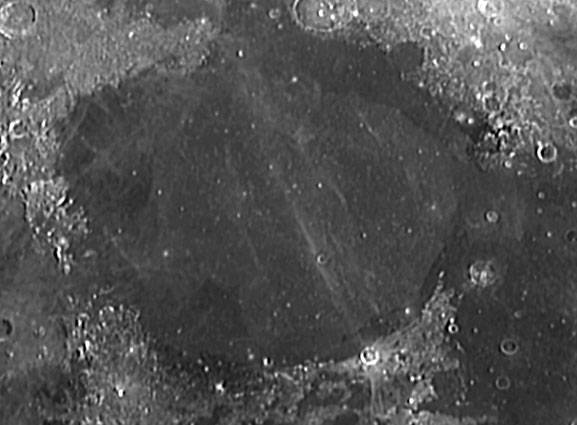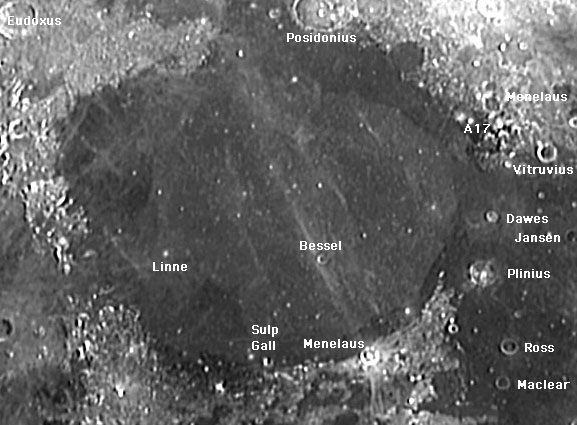Difference between revisions of "August 27, 2004"
| (3 intermediate revisions by the same user not shown) | |||
| Line 1: | Line 1: | ||
__NOTOC__ | __NOTOC__ | ||
=Serenitatis in Black and White and Gray= | =Serenitatis in Black and White and Gray= | ||
| + | <!-- Start of content --> | ||
<br> | <br> | ||
<table width="85%" border="0" align="center" cellpadding="6" cellspacing="2"> | <table width="85%" border="0" align="center" cellpadding="6" cellspacing="2"> | ||
| Line 11: | Line 12: | ||
<table width="80%" border="0" align="center" cellpadding="8"> | <table width="80%" border="0" align="center" cellpadding="8"> | ||
<tr> | <tr> | ||
| − | <td><div align="center" class="main_sm"> | + | <td><div align="center" class="main_sm"> |
| + | Image Credit: [mailto:kcpaulhk@yahoo.com.hk K.C. Pau ] | ||
| + | </div></td> | ||
</tr> | </tr> | ||
</table> | </table> | ||
| Line 25: | Line 28: | ||
12 Oct 2003. 10" f/6 Newtonian prime focus with Philips Toucam Pro.</p> | 12 Oct 2003. 10" f/6 Newtonian prime focus with Philips Toucam Pro.</p> | ||
<p><b>Related Links: </b><br> | <p><b>Related Links: </b><br> | ||
| − | [ | + | [http://www.lpi.usra.edu/research/lunar_orbiter/images/img/iv_085_h2.jpg Plinius area, Lunar Orbiter IV] </p> |
<p><b>Yesterday's LPOD:</b> [[August 26, 2004|A Lost 40 Year Old Dome Catalog]] </p> | <p><b>Yesterday's LPOD:</b> [[August 26, 2004|A Lost 40 Year Old Dome Catalog]] </p> | ||
<p><b>Tomorrow's LPOD:</b> [[August 28, 2004|Volcanic Hills in the Ocean of Storms]] </p> | <p><b>Tomorrow's LPOD:</b> [[August 28, 2004|Volcanic Hills in the Ocean of Storms]] </p> | ||
| Line 45: | Line 48: | ||
<!-- Cleanup of credits --> | <!-- Cleanup of credits --> | ||
<!-- Cleanup of credits --> | <!-- Cleanup of credits --> | ||
| − | < | + | <!-- Cleanup of credits --> |
| − | + | <!-- Cleanup of credits --> | |
| − | + | {{wiki/ArticleFooter}} | |
| − | |||
| − | ---- | ||
| − | |||
| − | |||
| − | |||
| − | <!-- | ||
| − | |||
| − | --> | ||
| − | |||
| − | |||
| − | |||
| − | |||
| − | |||
Latest revision as of 13:33, 15 March 2015
Serenitatis in Black and White and Gray
Image Credit: K.C. Pau |
|
Serenitatis in Black and White and Gray As sunrise creeps across the lunar surface, all telescopes are glued to that magic zone of long shadows and subtle topography. Thus each spot on the Moon is only observed for the day of sunrise and a few days following, and then ignored until the next lunation (who really observes the sunset terminator?). But cast a glance at the bright lands far from the terminator and you will discover things you never knew. I do. On this near full Moon view of Mare Serenitatis a number of things pop out. First, Serenitatis isn't round - the northwest section is not only angular but bulges out. Some U.S. Geological Survey scientists have proposed that another basin is there. The second obvious feature is the dark ring along the edges of Serenitatis. The dark lavas are older and titanium-rich, and the younger, lighter-hued ones in the middle are poorer in titanium. Much darker material occurs at the Apollo 17 site and west of the Sulpicius Gallus crater. This black material is volcanic ash with dark beads of glass. The high sun also shows interesting features on crater interiors. Plinius has a cross of brightness centered on it's central peak, and Jansen and Ross have surprisingly dark floors. Dawes is surrounded by a partial ring of dark material. Finally, this is the best time to find Linne because its bright nimbus makes it the most conspicuous object in western Serenitatis. Technical Details: Related Links: Yesterday's LPOD: A Lost 40 Year Old Dome Catalog Tomorrow's LPOD: Volcanic Hills in the Ocean of Storms |
Author & Editor: COMMENTS?Register, Log in, and join in the comments.
|





